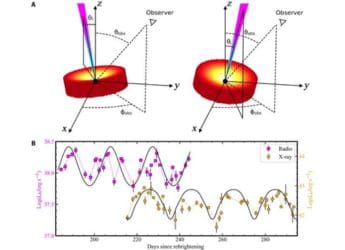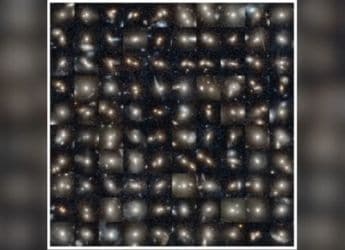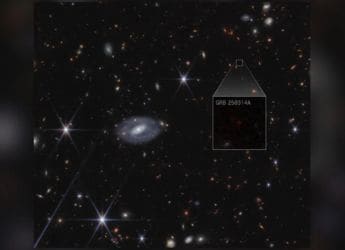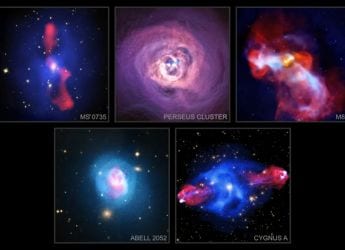- Home
- Science
- Science News
- JWST Discovers Jupiter Mass Binary Objects in Orion Nebula, Offering New Clues
JWST Discovers Jupiter-Mass Binary Objects in Orion Nebula, Offering New Clues
James Webb Telescope uncovers Jupiter-mass binary objects in the Orion Nebula, hinting at unique stellar formation conditions.

Photo Credit: ESA/Webb, NASA, CSA, Mahdi Zamani (ESA/Webb), PDRs4ALL ERS Team)
JWST's image of the Orion Nebula reveals free-floating, Jupiter-sized planets
Dozens of massive planet-like objects, observed by the James Webb Space Telescope (JWST) in the Orion Nebula, are believed to hold clues about stellar formation and disruption. These objects, referred to as Jupiter-mass binary objects (JuMBOs), comprise pairs of rogue gas giants, with masses between 0.7 and 30 times that of Jupiter, orbiting each other at significant distances of 25 to 400 astronomical units (AU).
Findings from the Orion Nebula
The study exploring their origin has been detailed in The Astrophysical Journal on November 5. The objects are located in the trapezoid region of the Orion Nebula, a known stellar nursery. According to reports, JuMBOs are thought to have formed under unique conditions not observed elsewhere. Current theories consider various possibilities, such as gravitational dynamics ejecting them from their home systems or a scenario where they formed near stars before being forced into independent orbits. However, the recent study proposes that they may represent failed stars, created when embryonic stars lost mass due to intense radiation.
Insights from Researchers
Richard Parker, a senior lecturer in astrophysics at the University of Sheffield, who co-authored the study, shared with Live Science that the observed wide separations between JuMBO pairs set them apart from other brown dwarfs in the galaxy. The study explored whether these binary systems might have originated from pre-stellar cores subjected to extreme radiation from nearby massive stars. These intense conditions, theorised by Anthony Whitworth and Hans Zinnecker two decades ago, could erode a core's outer layers and compress its centre, potentially leading to the creation of JuMBOs.
Simulations Shed Light on Formation
Parker, along with Jessica Diamond, a doctoral student and lead author, conducted simulations by exposing virtual pre-stellar cores to conditions mimicking high-energy radiation. The outcomes closely matched the JuMBOs in terms of size and orbital distance. While these findings present a plausible formation process, Parker stressed that further studies in other star-forming regions, like the Scorpius-Centaurus association, could validate the hypothesis.
The research highlights how little is currently known about these enigmatic systems, leaving room for alternative theories and ongoing investigation.
Get your daily dose of tech news, reviews, and insights, in under 80 characters on Gadgets 360 Turbo. Connect with fellow tech lovers on our Forum. Follow us on X, Facebook, WhatsApp, Threads and Google News for instant updates. Catch all the action on our YouTube channel.
Related Stories
- Samsung Galaxy Unpacked 2025
- ChatGPT
- Redmi Note 14 Pro+
- iPhone 16
- Apple Vision Pro
- Oneplus 12
- OnePlus Nord CE 3 Lite 5G
- iPhone 13
- Xiaomi 14 Pro
- Oppo Find N3
- Tecno Spark Go (2023)
- Realme V30
- Best Phones Under 25000
- Samsung Galaxy S24 Series
- Cryptocurrency
- iQoo 12
- Samsung Galaxy S24 Ultra
- Giottus
- Samsung Galaxy Z Flip 5
- Apple 'Scary Fast'
- Housefull 5
- GoPro Hero 12 Black Review
- Invincible Season 2
- JioGlass
- HD Ready TV
- Laptop Under 50000
- Smartwatch Under 10000
- Latest Mobile Phones
- Compare Phones
- Redmi Note 15 5G
- Redmi Note 15 Pro 5G
- Redmi Note 15 Pro+ 5G
- Lava Play Max
- Poco C85 5G
- Honor Magic 8 Lite
- Jolla Phone
- Realme P4x 5G
- Asus ProArt P16
- MacBook Pro 14-inch (M5, 2025)
- OnePlus Pad Go 2
- Poco Pad M1
- Just Corseca Skywatch Pro
- Honor Watch X5
- Acerpure Nitro Z Series 100-inch QLED TV
- Samsung 43 Inch LED Ultra HD (4K) Smart TV (UA43UE81AFULXL)
- Asus ROG Ally
- Nintendo Switch Lite
- Haier 1.6 Ton 5 Star Inverter Split AC (HSU19G-MZAID5BN-INV)
- Haier 1.6 Ton 5 Star Inverter Split AC (HSU19G-MZAIM5BN-INV)

















